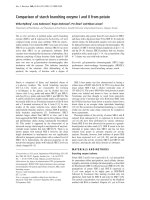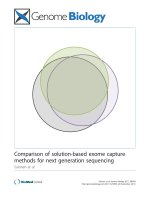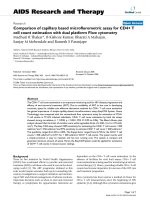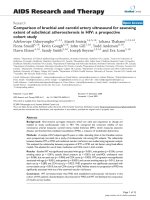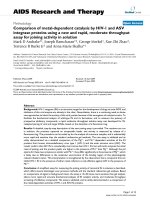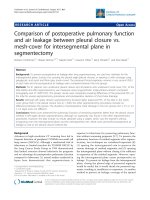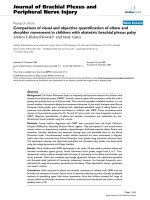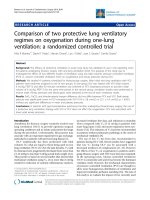Báo cáo y học: "Comparison of capillary based microflurometric assay for CD4+ T cell count estimation with dual platform Flow cytometr" pps
Bạn đang xem bản rút gọn của tài liệu. Xem và tải ngay bản đầy đủ của tài liệu tại đây (257.19 KB, 7 trang )
BioMed Central
Page 1 of 7
(page number not for citation purposes)
AIDS Research and Therapy
Open Access
Research
Comparison of capillary based microflurometric assay for CD4+ T
cell count estimation with dual platform Flow cytometry
Madhuri R Thakar*, B Kishore Kumar, Bharati A Mahajan,
Sanjay M Mehendale and Ramesh S Paranjape
Address: National AIDS Research Institute, Bhosari, Pune 411026, India
Email: Madhuri R Thakar* - ; B Kishore Kumar - ;
Bharati A Mahajan - ; Sanjay M Mehendale - ;
Ramesh S Paranjape -
* Corresponding author
Abstract
The CD4+ T cell count estimation is an important monitoring tool for HIV disease progression and
efficacy of anti-retroviral treatment (ART). Due to availability of ART at low cost in developing
countries, quest for reliable cost effective alternative methods for CD4+ T cell count estimation
has gained importance. A simple capillary-based microflurometric assay (EasyCD4 System, Guava
Technology) was compared with the conventional flow cytometric assay for estimation of CD4+
T cell counts in 79 HIV infected individuals. CD4+ T cell count estimation by both the assays
showed strong correlation (r = 0.938, p < 0.001, 95% CI 0.90 to 0.96). The Bland Altman plot
analysis showed that the limits of variation were within agreeable limits of ± 2SD (-161 to 129 cells/
mm
3
). The Easy CD4 assay showed 100% sensitivity for estimating the CD4+ T cell counts < 200
cells/mm
3
and < 350 cells/mm
3
and 97% sensitivity to estimate CD4+ T cell count < 500 cells/mm
3
.
The specificity ranged from 82 to 100%. The Kappa factor ranged from 0.735 for the CD4+ T cell
counts < 350 cells/mm
3
to 0.771 for < 500 cells/mm
3
CD4+ T cell counts. The system works with
a simple protocol, is easy to maintain and has low running cost. The system is compact and
generates minimum amount of waste. Hence the EasyCD4 System could be applied for estimation
of CD4+ T cell counts in resource poor settings.
Background
Three by five initiative by World Health Organization
(WHO) has accelerated efforts to provide anti-retroviral
treatment (ART) to all those who need it even in the devel-
oping world [1]. The ART programme initiated at this
scale would require extensive back up for counseling, lab-
oratory investigations to support initiation and monitor-
ing of ART and clinical management of adverse reactions.
Important decisions such as when to start anti-retroviral
therapy or prophylaxis for opportunistic infections are
dependent on the CD4+ T cell count estimation. In the
absence of facilities for viral load assays, CD4+ T cell
count estimations is being used for monitoring of anti-ret-
roviral therapy [2]. Hence, providing reliable CD4+ T cell
counts has become imperative for success of the HIV care
and treatment programme.
Flow cytometry has been used as a method of choice for
CD4+ T cell measurements since the beginning of HIV
epidemic [3,4]. Although flow cytometric estimations give
Published: 16 October 2006
AIDS Research and Therapy 2006, 3:26 doi:10.1186/1742-6405-3-26
Received: 26 June 2006
Accepted: 16 October 2006
This article is available from: />© 2006 Thakar et al; licensee BioMed Central Ltd.
This is an Open Access article distributed under the terms of the Creative Commons Attribution License ( />),
which permits unrestricted use, distribution, and reproduction in any medium, provided the original work is properly cited.
AIDS Research and Therapy 2006, 3:26 />Page 2 of 7
(page number not for citation purposes)
robust and reliable estimations, its high initial and run-
ning costs and need for skilled manpower have placed
limitations on wider use of flow cytometry in the resource
poor settings.
Hence, alternative methods for CD4+ T cell count estima-
tion with lower costs and simplicity in techniques are
being explored worldwide [5,6]. The EasyCD4 System is
manufactured and marketed by Guava technologies Inc.,
USA. The system consists of a cell analysis instrument
called PCA, a lap top computer with the Guava EasyCD4
software and reagents. The system works on principles of
flow cytometry with some modifications. It uses micro
capillary as a flow cell unlike the conventional flow
cytometry. The whole blood sample is stained with anti-
CD3+ (T cell surface marker; present on all T cells) anti-
bodies tagged with phycoerythrin (PE)-Cy5 and anti-
CD4+ antibodies tagged with PE. The system uses two-flu-
orescence parameters (CD3-PE Cy5 and CD4-PE) in com-
bination with forward scatter (FSC) as a measure of
relative cell size to analyze the cell population of interest.
The CD4+ T cell number is then estimated as the cells
simultaneously expressing CD3 and CD4 markers.
We compared the CD4+ T cell estimations in HIV infected
individuals using EasyCD4 System with the conventional
flow cytometry.
Results
Thirty-one of the 79 study subjects were females and 48
were males with mean age of 29 and 36 years respectively.
The CD4+ T cell counts estimated using EasyCD4 System
and flow cytometry showed strong correlation (r = 0.938,
p < 0.001, 95% CI 0.90 to 0.96) (figure 1).
The mean absolute count of CD4+ T cells was 306 ± 207
cells/mm
3
by the flowcytometry and 290 ± 203 cells/mm
3
by the EasyCD4 System. The CD4+ T cell counts estimated
in the population under study ranged from 10 to 1110
cells/mm
3
by flow cytometer. Hence, the sensitivity and
specificity of the Easy CD4 assay was calculated for differ-
ent categories of CD4+ T cell count as < 200, < 350 and <
500 cells/mm
3
. The Easy CD4 assay showed 100% sensi-
tivity for correct estimation of the CD4+ T cell counts <
200 cells/mm
3
and < 350 cells/mm
3
and 97% sensitivity
to estimate CD4+ T cell count < 500 cells/mm
3
. The spe-
cificity ranged from 82 to 100% (Table 1).
The degree of agreement was estimated by kappa factor
(Table 1). The Kappa factor ranged from 0.735 for the
CD4+ T cell counts < 350 cells/mm
3
to 0.771 for < 500
cells/mm
3
CD4+ T cell counts. The Bland-Altman plots
also showed that the variation in CD4+ T cell counts
between the two methods was within agreeable limits of
± 2 Standard Deviation (SD) (figure 2). The distribution
of error was found to be bi-directional.
The comparison between the operational aspects of the
two methods is given in Table 2.
A limited number of samples (N = 10) were additionally
processed by FACSCount (Cat. No.: D0480 Becton Dick-
inson, USA), a single platform system. The mean CD4
counts obtained by FACSCount and Guava EasyCD4 sys-
tem were 218 and 221 cells/mm
3
respectively. The values
obtained by both the methods showed strong correlation
(r: 0.98, p < 0.001).
The performance of EasyCD4 assay on five stabilized
blood samples showed satisfactory performance within
acceptable range of ± 2SD (figure 3).
The intra-sample variation in the EasyCD4 assay was
assessed in four samples for the CD4 counts obtained on
the same day and after 24 hours. The mean % coefficient
of variation (CV) was found to be 6.75% in the range of 1
to 18% while the mean % CV of duplicate testing was
found to be 5.17 % (range: 1 to 13%).
Discussion
Flow cytometry has been accepted as a gold standard for
estimating CD4+ T cell count. However, it has high initial
as well as running cost and requires frequent mainte-
nance. The frequent power failures, unavailability of tem-
perature controlled laboratories make the maintenance of
flow cytometer difficult. Hence the use of flow cytometry
is constrained in resource-poor settings. A number of
alternative assays have been developed and some are com-
Correlation plot of CD4 cell counts as determined by flow-cytometry for CD4+ using dual platform (X -axis) and by the EasyCD4 System (Y axis)Figure 1
Correlation plot of CD4 cell counts as determined by flow-
cytometry for CD4+ using dual platform (X -axis) and by the
EasyCD4 System (Y axis).
0
200
400
600
800
1000
0 200 400 600 800 1000
CD4 (FACSORT)
CD4 (Guava)
AIDS Research and Therapy 2006, 3:26 />Page 3 of 7
(page number not for citation purposes)
mercially available, i.e., Dynal CD4 assay using magnetic
beads and Coulter Cytoshpere assay. These two micro-
scope-based assays were found to be highly comparable
with the Flow cytometry [7-9]. However, these alternative
assays are fairly labor intensive and, thus less appropriate
for testing of a large number of samples. Rodriguez et al
developed a microchip-based method for estimation of
CD4 percentages at low cost [10]. In addition, modified
flow cytometry assays such as a combination of dual plat-
form system and pan-leucogating has shown that reliable
estimation of CD4+ T cell count is possible at a reduced
cost [11]. Combination of automatic gating with volumet-
ric flow cytometry has been shown to be efficient and
gives accurate CD4+ T cell count estimation [12]. The sin-
gle platform bead based assays available till date were
found to be robust, reliable however, expensive.
The EasyCD4 System from Guava Technologies evaluated
in the present study is a modified flow cytometer that uses
simple volumetric micro capillary-based technology
instead of conventional flow cell using sheath fluid for
carrying the cells. In conventional flow cytometry, the
sheath fluid carries the cells through the LASER path to
maintain a single cell suspension so that only one-cell
passes through laser beam at one time. In Guava PCA the
cells pass through a micro capillary eliminating need of
sheath fluid for maintaining single cell suspension. Due
to this modification, the volume of accumulated waste is
20 times less than the conventional flow cytometry. Addi-
tionally, the conventional flow cytometry in the present
study uses the dual side scatter gating depending upon cell
morphology (size (FSC) and granularity (SSC)), where as
the guava Easy CD4 System uses T cell gating strategy to
gate CD3+ cells and estimates CD3+CD4+ cells. The gat-
ing on CD3+ T cells removes the monocytes (expressing
CD4 but not CD3 on their cell surface) from the gate. The
Easy CD4 System is a single platform volumetric system
that calculates absolute CD4+ T cell counts on the basis of
volume of sample acquired. This eliminates the variability
introduced by using Absolute Lymphocyte Count (ALC)
from the other analyzer as in dual platform system used in
conventional flow cytometry.
The CD4+ T cell counts estimated by EasyCD4 System
showed high correlation with the CD4+ T cell counts
obtained by conventional flow Cytometry and showed
high sensitivity and specificity to identify patients with
CD4 + T cell count < 500 cells/mm
3
, < 350 cells/mm
3
and
< 200 cells/mm
3
. The degree of agreement is high as
showed by kappa factor. The Bland-Altman analysis,
which is a more reliable method to assess variation, also
showed that the variation was within agreeable limits.
Hence the method is reliable for making decisions on
starting ART or prophylaxis for opportunistic infections.
The assay has shown very good agreement with single
platform technology like FACSCount or multiTest assay
using flowcytometer (13–16) and in the present study
although on limited sample size.
Bland Altman plot analysis of the CD4+ T cell counts obtained by Easy CD4 assay (Guava) and flow cytometryFigure 2
Bland Altman plot analysis of the CD4+ T cell counts
obtained by Easy CD4 assay (Guava) and flow cytom-
etry. Bland-Altman plot comparing absolute CD4 cell counts
estimated by Guava EasyCD4 assay and conventional flowcy-
tometry. The dark continuous line drawn indicates the bias
(mean difference), and the dotted lines are the limits of
agreement (mean ± 2 SD).
-300
-200
-100
0
100
200
300
0 200 400 600 800 1000
Average CD4 by two methods
Difference in CD4 (Guava-Flow
cytometry)
Table 1: kappa factor and sensitivity and specificity for absolute CD4+ counts determined by EasyCD4 assay.
N CD4+ T cell count (cells/mm
3
) Kappa value Sensitivity Specificity
Mean Median
FC* EasyCD4** FC* EasyCD4**
Total 79 306 290 280 284
CD4 < 500 70 252 227 249 239 0.771 100% 95%
CD4 < 350 52 196 192 210 205 0.735 100% 82%
CD4 < 200 24 108 104 118 112 0.741 97% 100%
*: FC = Flowcytometer
**: Easy CD4: Guava EasyCD4 System
AIDS Research and Therapy 2006, 3:26 />Page 4 of 7
(page number not for citation purposes)
The intra-sample %CV in Easy CD4 assay as 6.75% (1 to
18 %), which was comparable with the values (5 to 13%)
reported in previous studies (15,16) and less than the
%CV reported for "double-platform" systems ranging
form 14.5 to 43.4% (mean, 23.4%) (17). Hence, the Easy
CD4 assay could be better than the double platform sys-
tem.
The assay showed satisfactory performance when five sta-
bilized blood samples were assessed for CD4+ T cell
counts.
As compared to the conventional flow cytometry the
EasyCD4 System was found to be simple to operate, easy
to maintain and the equipment requires less space. Since
it requires only 10 μl of sample it is possible to explore its
application using finger prick blood samples. Hence, it
can be adopted for CD4+ T cell count estimation in HIV
infected individuals. The running cost of the CD4+ T cell
estimation by EasyCD4 System is 5 times lower than the
conventional flowcytometry at the current costing. How-
ever, the pricing of the reagents and instruments might be
subjected to change due to higher demand and wider
choice of technologies available to the customer.
EasyCD4 assay, although operationally simple, the users
need training in gating of the CD3+ T lymphocytes. The
use of minimum quantity of antibodies (1 μl of antibody
cocktail) requires precision in technique of reverse pipet-
ting used in case of minute quantities of reagents using the
air displacement pipettes as described (18). Also, the
EasyCD4 System does not prescribe validity criteria for
assessing the formation of the gate. This was found to be
extremely critical for reliable gating for accurate estima-
tion of CD4+ T cell counts, to minimize the variations in
CD3+ T cell counts and to overcome the acquisition of
debris causing high event rate. The laboratory using the
equipment needs to set up such criteria locally such as use
of commercially available controls or use of healthy indi-
viduals sample for gating the CD3+ T cells. This essentially
highlights the need of development of laboratory based
quality control check on the equipment.
Conclusion
In conclusion, the availability of EasyCD4 System
enhances the options for reliable and valid CD4+ T cell
count estimation technology for HIV infected individuals.
The validation of the system on finger prick samples could
be taken up to assess the simplicity of sample collection
and cost reduction.
Methods
Study subjects and CD4+ T cell count estimation
79 HIV infected individuals attending the referral clinic of
National AIDS Research Institute (NARI), Pune were
enrolled in the study after obtaining written informed
consent from 5 February to 21 April 2004. The blood sam-
performance of stabilized blood samples in the guava EasyCD4 assayFigure 3
performance of stabilized blood samples in the guava
EasyCD4 assay. The figure shows performance of stabilized
blood samples (samples received for proficiency assessment)
in the Guava easy CD4 assay. The error bar shows ± 2 SD of
the mean CD4 counts/mm3 (-) for that proficiency run. The
CD4 counts obtained by Guava EasyCD4 assay ( ) are
between the limit of ± 2SD.
0
100
200
300
400
500
600
700
0123456
samples
CD 4 counts/m m
3
Table 2: Operational comparison of the two methodologies
Sr. No. Parameter EasyCD4 System Conventional flow cytometry (FACSort)
1. Ease of performance Excellent Good
2. Volume of blood required/test 10 μl100 μl
3. Reagents required/test
a. Antibodies 1 μl/sample 20 μl/sample
b. Sheath fluid 50 ml/sample
c. RBC Lysing solution 18 μl/sample 120 μl/sample
4. Generation of waste/test 200 μl/sample 18 ml/sample
5. Time required to process one sample 35 minutes 90 minutes
6. Routine maintenance: Cleaning procedure Daily (5 minutes) Monthly ( ) Daily (20 minutes) Monthly (90 minutes)
AIDS Research and Therapy 2006, 3:26 />Page 5 of 7
(page number not for citation purposes)
ple was collected in a vacutainer containing K3 EDTA to
avoid clotting of blood.
The CD4 + T cell counts were estimated by dual platform
Flow cytometry (FACSORT, BD 206, Becton Dickinson,
USA) as a part of routine investigations using IMK Plus kit
(Cat # 349217, BD, USA). The kit included a panel of
monoclonal antibodies of CD45-Fluorescein Isothiocy-
nate (FITC)/CD14-Phycoerythrin (PE), CD3-FITC/CD19-
PE, CD4-FITC/CD8-PE, CD3-FITC/CD3 HLA-DR-PE and
CD3-FITC/CD16+56-PE and SimulSET software. Hun-
dred μl of noncoagulated blood was stained with 20 μl of
each of the antibody pair. After 30 minutes incubation the
red blood cells were lysed using freshly diluted (1:10)
FACS lysing solution (Cat. No.: 349202, Becton Dickin-
son, USA). The samples were then acquired in the instru-
ment and the lymphocytes were gated on the basis of size
(Forward scatter: FSC) and relative granularity (Side scat-
ter: SSC) for further analysis. Two-colour analysis for each
antibody subset was performed to obtain percentages of
each lymphocyte subset. The run was considered valid
only if more than 95% lymphocytes were in the gate.
The absolute CD4+ T cell counts were computed by feed-
ing the ALC in the SimulSET software and were expressed
as cells/mm
3
. These ALCs were obtained on the hematol-
ogy analyzer (Sysmex, Kx21).
CD4+ T cell count estimation by EasyCD4 System
An aliquot of the same blood samples were coded to blind
the technician and processed by Guava Easy CD4 assay
(Guava Technologies, USA) on the same day of sample
collection. The coding was carried out only when at least
three samples were available on a given day to ensure
blinding of the laboratory technician.
Ten μl of noncoagulated blood was stained with 1:10
diluted antibody cocktail of CD3-PE-Cy5 and CD4-PE or
CD3-PE-Cy5 and CD8-PE separately for 15 minutes at
room temperature in dark and the RBCs were lysed using
the freshly prepared lysing solution for 15 minutes. The
instrument was calibrated daily using Guava check beads
(cat# 42000070) in triplicate and the instrument was con-
sidered to be ready for use if the average CV% for FSC
intensity and PM1 and PM2 mean fluorescence Index
(MFI) of all three replicates is within 1–5. The sample was
acquired within five hours of staining using Cytosoft soft-
ware. The gate was automatically set around the CD3+ T
lymphocytes using the scatter plot showing cells stained
with antibodies against CD3 conjugated to PECy5 and the
size of the cells as shown in figure 4; plot A. The
CD3+CD4 + T cells were further gated using two-fluores-
cence scatter plot of CD3-PECy5 and CD4-PE (Figure 4;
plot B). The Cytosoft software calculates the absolute
CD4+ T cell count from total number of cells within the
Scatter plots showing CD3+ T cell gating and CD3+CD4+ T cells in EasyCD4 SystemFigure 4
Scatter plots showing CD3+ T cell gating and CD3+CD4+ T cells in EasyCD4 System. Plot A: CD3+ cells (in red)
are gated using the size (FSC: X axis) and the CD3-PECy5 staining (PM2: Y axis) using the threshold setting markers. Plot B:
CD3+CD4+ T cells are gated in CD4 analysis gate using two-color fluorescence CD4- PE (PM1: X axis) and CD3- PECy5
(PM2: Y axis) using the threshold setting markers.
&'7FHOOV
&'FRXQWLQJJDWH
7KUHVKROGVHWWLQ
J
&'DQDO\VLVJDWH
&'&'
7FHOOV
7KUHVKROGVHWWLQ
J
Plot A Plot B
AIDS Research and Therapy 2006, 3:26 />Page 6 of 7
(page number not for citation purposes)
CD4 analysis gate (tCD4), volume of the sample taken up
during data acquisition (v) and the dilution factor (df)
using the following formula,
Absolute CD4+ T cell count/mm
3
= (tCD4 × df)/v cells.
During the preliminary experiments, it was observed that
in few cases there was variation in the CD3+ T cell counts
obtained in both, sample tubes estimating CD4+ and
CD8+ T cell counts and also there was variations in the
event rate (no of cells acquired per second). The high
event rate was found to occur in case of the samples hav-
ing a high proportion of non-lymphocyte population in
the sample. So the run was considered valid if the varia-
tion between the CD3+ T cell counts in both sample tubes
(used to estimate CD4 and CD8 T cell counts) was less
than 10%, the event rate of acquisition of the sample was
less than 700/μl and the CD3+ cells acquired in the gate
ranged from 1000 to 2000 cells/μl.
Data analysis
At the end of the study, the CD4+ T cell counts obtained
by the EasyCD4 System were decoded and compared with
the CD4+ T cell counts obtained by the flowcytometry.
The correlation between the two methods was assessed
using Pearson's correlation test and the degree of agree-
ment was estimated by calculating the kappa factor. The
Bland-Altman plots were generated for assessment of the
variation between the two methods. The sensitivity and
specificity of the Easy CD4 assay was estimated for differ-
ent ranges of CD4+ T cell counts. Data analysis was carried
out using SPSS statistical package (version 12.0) to calcu-
late degree of agreement, and to calculate correlation coef-
ficient. The percent coefficient of variation (%CV) was
calculated to assess intra-sample variation by using Micro-
soft Excel software.
Competing interests
The author(s) declare that they have no competing inter-
ests.
Authors' contributions
MT conceived of the study, and participated in its design,
coordination and drafted the manuscript. BM carried out
the CD4+ T cell count estimation assays. BK participated
in the design of the study and performed the statistical
analysis. SM and RP participated in design of the study,
monitored the progress and reviewed the draft of the
manuscript. All authors read and approved the final man-
uscript.
Acknowledgements
We thank the clinic staff of the National AIDS Research Institute for pro-
viding blood samples and the Guava Technologies, USA for providing the
reagents and equipment
References
1. Treating 3 Million by Making It Happen. The WHO Strategy:
The WHO and UNAIDS global initiative to provide antiret-
roviral therapy to 3 million people with HIV/AIDS in devel-
oping countries by the end of 2005 / Treat 3 Million by 2005
[ />3by5StrategyMakingItHappen.pdf]. Accessed on 13th Nov. 2006
2. Kovacs JA, Masur H: Prophylaxis against opportunistic infec-
tions in patients with human immunodeficiency virus infec-
tion. N Engl J Med 2003, 342:1416-29.
3. Brando B, Barnett D, Janossy G, Mandy F, Autran B, Rothe G, Scarpati
B, D'Avanzo G, D'Hautcourt JL, Lenkei R, Schmitz G, Kunkl A, Chi-
anese R, Papa S, Gratama JW: Cytoflurimetric methods for
assessing absolute numbers of cell subsets in blood. Cytometry
2000, 42:327-346.
4. Crowe S, Turnbull S, Oelrichs R: Monitoring of human immuno-
deficiency virus infection in resource-constrained countries.
Clin Infect Dis 2003, 37(Suppl 1):S25-S35.
5. Pattanapanyasat K, Thakar MR: CD4+ T cell count as a tool to
monitor HIV progression & anti-retroviral therapy. Indian J
Med Res 2005, 121(4):539-49.
6. Nicholson JK, Velleca WM, Jubert S, Green T, Bryan L: Evaluation
of alternative CD4 technologies for the enumeration for
CD4 lymphocytes. J Immunol Methods 1994, 28:43-54.
7. Carella AV, Moss MW, Provost V, Quinn TC: A manual bead assay
for the determination of absolute CD4 + and CD8 + lym-
phocyte counts in human immunodeficiency virus- infected
individuals. Clin Diagn Lab Immunol 1995, 2(5):623-5.
8. Didier JM, Kazatchkine MD, Demouchy C, Moat C, Diagbouga S,
Sepulveda C, Di Lonardo AM, Weiss L: Comparative assessment
of five alternative methods for CD4+ T- lymphocyte enu-
meration for implementation in developing countries. J
Acquir Immune Defic Syndr 2001, 26:193-195.
9. Landay A, Ho J, Hom D, Russell T, Zweener R, Minsty J: A rapid
manual method for CD4+ T-cell quantitation for use in
developing countries. AIDS 1993, 7(12):1565-8.
10. Rodriguez W, Mohanty M, Christodoulides N, Goodey A,
Romanovicz D, Ali M, Floriano P, Walker B, McDevitt J: Develop-
ment of affordable, portable CD4 counts for resource- poor
settings using microchips (abstract 175lb). Presented at the 10th
conference on retroviruses and Opportunistic Infections at Boston 2003.
11. Glencross D, Scott LW, Jani IV, Barnett D, Janossy G: CD45
assisted PanLeucogating for Accurate, Cost Effective Dual
Platform CD4+ T cell Enumeration. Cytometry (CCC) 2002,
50(2):69-77.
12. Janossy G, Jani IV, Bradley NJ, Arsene B, Pitfield T, Florino P, et al.:
Affordable CD4
+
T – cell counting by flow cytometery: CD45
gating for volumetric analysis. Clin Diagn Lab Immunol 2002,
9:1035-94.
13. Josefowicz S, Buchner L, Epling C, Sinclair E, Bredt B: A Simple,
Low-cost CD4
+
T-cell Assay: Comparison of the Guava Easy
CD4 and the BD Biosciences MultiTest Assays for the Deter-
mination of CD4
+
T-cell Counts in HIV-1-Seropositive and -
Seronegative Volunteers. In 11th conference on Retroviruses and
opportunistic infections San Francisco, USA. Feb 8–11,2004
14. Kandathil AJ, Kannangai R, David S, Nithyanandam G, Solomon S,
Balakrishnan P, Abraham O, Subramanian S, Rupali P, Verghese VP,
Pulimood S, Sridharan G: Comparison of Microcapillary Cytom-
etry Technology and Flow Cytometry for CD4_and CD8_ T-
Cell Estimation. Clin Diagn Lab Immunol 2005, 12(8):1006-1009.
15. Josefowicz S, Elad K, Liu E, K'Aluoch OF, Tran K, Tyagarajan K, Buch-
ner LH, Sheppard W, Martin Bigos C: Lorrie Epling, Elizabeth
Sinclair, Barry Bredt Guava Technologies EasyCD4(tm) and
EasyCD8(tm) Assays vs. the BD Biosciences MultiTest(tm)
Assay for the Enumeration of Human CD4+ and CD8+ T
cells – Three-site Evaluation. Clinical Cytometry Meeting, Poster No
32, Long Beach . October 17 th–19 th, 2004.
16. Josefowicz S, Louzao R, Lam L, Ding T, Bergeron M, Henderson LJ,
Mulder CB, Tyagarajan K, Buchner L, Gelman R, Denny TN, Spira TJ,
Mandy F, Landay A, Bredt : Five site evaluation of the Guava
EasyCD4 Assay for the En4+ T cells. In 12 th Conference on Ret-
roviruses and Opportunistic Infections Poster No. U-138 Boston, MA,
USA. February 22–25, 2005
17. Barnett D, Granger V, Whitby L, Storie I, Reilly JT: Absolute CD4_
T-lymphocyte and CD34_ stem cell counts by single-plat-
Publish with BioMed Central and every
scientist can read your work free of charge
"BioMed Central will be the most significant development for
disseminating the results of biomedical researc h in our lifetime."
Sir Paul Nurse, Cancer Research UK
Your research papers will be:
available free of charge to the entire biomedical community
peer reviewed and published immediately upon acceptance
cited in PubMed and archived on PubMed Central
yours — you keep the copyright
Submit your manuscript here:
/>BioMedcentral
AIDS Research and Therapy 2006, 3:26 />Page 7 of 7
(page number not for citation purposes)
form flow cytometry: the way forward. Br J Haematol 1999,
106:1059-1062.
18. Mandy FF, Nicholson JKA, McDougaJ S: Guidelines for Performing
Single- Platform Absolute CD4+ T-Cell Determinations with
CD45 Gating for Persons Infected with Human Immunode-
ficiency Virus. MMWR Recommendations and reports 2003,
53(RR02):1-13.
